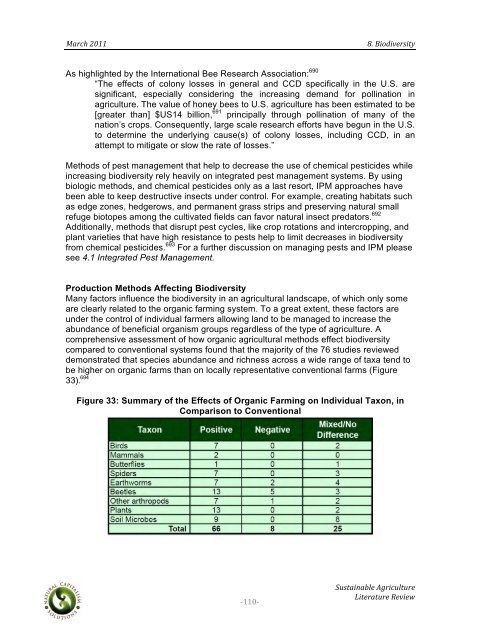Sustainable Agriculture Literature Review - Boulder County
Sustainable Agriculture Literature Review - Boulder County
Sustainable Agriculture Literature Review - Boulder County
Create successful ePaper yourself
Turn your PDF publications into a flip-book with our unique Google optimized e-Paper software.
! !!<br />
"#$%&!'())!! !!!!!!!!!!!!!!!!!!!!!!!!!!!!!!!!!!!!!!!!!!!!!!!!!!!!!!!!!!!!!!!!!!!!!!!C+!D.-E.;1$4.2F!<br />
As highlighted by the International Bee Research Association: 690<br />
“The effects of colony losses in general and CCD specifically in the U.S. are<br />
significant, especially considering the increasing demand for pollination in<br />
agriculture. The value of honey bees to U.S. agriculture has been estimated to be<br />
[greater than] $US14 billion, 691 principally through pollination of many of the<br />
nation’s crops. Consequently, large scale research efforts have begun in the U.S.<br />
to determine the underlying cause(s) of colony losses, including CCD, in an<br />
attempt to mitigate or slow the rate of losses.”<br />
Methods of pest management that help to decrease the use of chemical pesticides while<br />
increasing biodiversity rely heavily on integrated pest management systems. By using<br />
biologic methods, and chemical pesticides only as a last resort, IPM approaches have<br />
been able to keep destructive insects under control. For example, creating habitats such<br />
as edge zones, hedgerows, and permanent grass strips and preserving natural small<br />
refuge biotopes among the cultivated fields can favor natural insect predators. 692<br />
Additionally, methods that disrupt pest cycles, like crop rotations and intercropping, and<br />
plant varieties that have high resistance to pests help to limit decreases in biodiversity<br />
from chemical pesticides. 693 For a further discussion on managing pests and IPM please<br />
see 4.1 Integrated Pest Management.<br />
Production Methods Affecting Biodiversity<br />
Many factors influence the biodiversity in an agricultural landscape, of which only some<br />
are clearly related to the organic farming system. To a great extent, these factors are<br />
under the control of individual farmers allowing land to be managed to increase the<br />
abundance of beneficial organism groups regardless of the type of agriculture. A<br />
comprehensive assessment of how organic agricultural methods effect biodiversity<br />
compared to conventional systems found that the majority of the 76 studies reviewed<br />
demonstrated that species abundance and richness across a wide range of taxa tend to<br />
be higher on organic farms than on locally representative conventional farms (Figure<br />
33)- 694<br />
!<br />
Figure 33: Summary of the Effects of Organic Farming on Individual Taxon, in<br />
Comparison to Conventional<br />
"''&"<br />
!,342#.5#6/1!78$.%3/23$1!<br />
9.21$#23$1!:1;.1
















